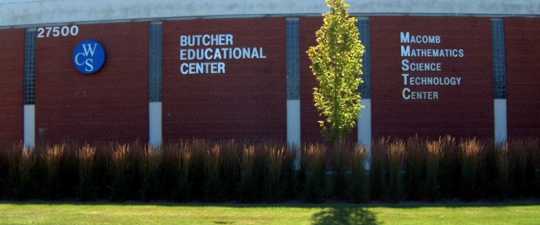 |
| Bauer Power of Grand Rapids shows off a small residential wind generator |
Posted: Tuesday, 03 March 2009 5:54PM
Wind Energy Conference Draws 1,300
Around 1,300 people gathered at Detroit's Cobo Center Tuesday for the opening day of the Michigan Wind Energy Conference, sponsored by the Great Lakes Renewable Energy Association.
The conference wraps up today with more keynotes and panels.
Jennifer Alvarado, executive director, said wind power remains a hot technology even in an era of cheaper energy prices because people want to reduce CO2 output, avoid looming carbon taxes -- and because it has the potential to bring thousands of new manufacturing jobs to Michigan.
Attending the event were manufacturers, consultants, attorneys, and developers of both large (utility-scale) and small (home-sized wind systems. A small unit atop a 30-foot flagpole, Alvarado said, in most cases will generate between 30 and 70 percent of a home's needs -- and you can sell excess electricity back to the utility though your meter.
Tuesday's lunch keynote, from Jim Walker of the American Wind Energy Association, noted that moving to 20 percent electricity from wind would cost only 2 percent more of the investment that needs to be made in new power plants and grids anyway, and would be the CO2 equivalent of removing 96 percent of the industrial sector's energy (and pollution) output.
Other tracks Tuesday afternoon covered wind energy supply chains and manufacturing, legal and financial issues, and large-scale commercial wind power.
Dan McDevitt of Nordex Power said 135,000 commercial wind turbines need to be built to get the United States to 20 percent wind power. About 2,400 were build last year, so a lot of building remains to be done.
The event wraps up today with keynotes from wind energy officials from the state of Minnesota and the United Kingdom. There will also be small group discussion tracks on small-scale wind projects, off-shore projects and commercial wind projects.
More at www.glrea.org.
Wind Energy Event Talks Up Offshore Power In Great Lakes
The Michigan Wind Energy Conference wrapped up at Cobo Center Wednesday with a look at offshore wind projects in the United Kingdom and their potential in Michigan, along with breakout sessions on small and community windpower projects.
Chris Jenner and Johnny Lewis of England's RPS Energy offered a comprehensive overview of their company's work on offshore wind power in Europe, specifically the United Kingdom, covering the challenges and successes of the technology.
Peter Mandelstam, founder and president of Bluewater Wind LLC of Delaware, gave a detailed presentation on the potential of offshore wind in the United States, including the Great Lakes.
"Offshore wind is the next wave -- lots of puns, folks, I warn you," Mandelstam began, adding that "the Northeast and the Great Lakes are natural markets."
Why? Because they offer stronger and more consistent winds than other shoreline areas, relatively shallow water depths even miles offshore, no significant water use conflicts, accessible transmission and ports, large available project area footprints, and little opposition from the public if the turbines are built more than 10 miles from shore (which makes them too small to see from the beach, for the most part).
Mandelstam said offshore wind power is a "great green job generator."
He said state and federal regulations, the reality of peak oil production nearing and climate change considerations are all forcing a move toward wind power.
Mandelstam also said those who don't think a carbon tax will happen should beware -- buried deep in the Obama Administration's budgets is the assumption of a $20-a-ton carbon tax by 2015.
Mandelstam said his company's current project off Delaware, Maryland and Virginia will create 500 construction jobs and 80 to 100 permanent operation and maintenance jobs, as well as a $1.6 billion investment.
During the question and answer session, he said there won't be a choice between onshore and offshore wind power -- we'll do both. And he also said the recent economic collapse has shown that neither economic extreme -- complete lassiez-faire and socialism -- works.
After the speeches, the throng broke up into small groups and I headed for the exhibit displays.
Tim Krauss of Fraser's Enmark Tool & Gage Co. Inc. told me he was at the conference looking for work for his company building components for wind generators. A machined part is a machined part, after all.
Bob Brown of Martin-based Bauer Power Inc. showed off a seven-foot circular wind turbine that generates 1,200 watts, intended for rooftop installation on commerical and industrial buildings. Also in display was a 140-watt solar array about the size of a dining room table. Neither is currently cost-competitive with power from the grid, but Brown said they represent "hedging your bets" against future price increases.
Peter Klein, associate dean at Macomb Community College, said he's talking with the industry in an attempt to tailor the school's renewable energy classes to meet industry needs. Every renewable class the school adds quickly fills up, he said.
Finally, I spoke to Mike Hess, co-founder and CEO of Mariah Power, which hopes to put 120 people to work by the end of the year in the Manistee area, building the company's unique vertical-axis wind generators.

No comments:
Post a Comment